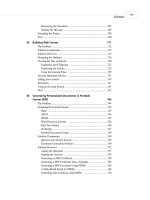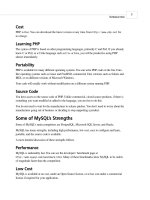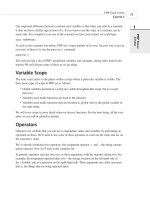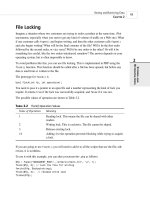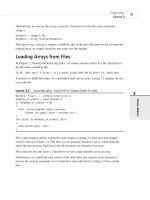Phát triển web với PHP và MySQL - p 7 ppsx
Bạn đang xem bản rút gọn của tài liệu. Xem và tải ngay bản đầy đủ của tài liệu tại đây (574 KB, 10 trang )
left xor
left and
right print
left = += -= *= /= .= %= &= |= ^= ~= <<= >>=
left ? :
left ||
left &&
left |
left ^
left &
n/a == != ===
n/a < <= > >=
left << >>
left + - .
left * / %
right ! ~ ++ (int) (double) (string) (array) (object) @
right []
n/a new
n/a ()
Notice that the highest precedence operator is one we haven’t covered yet: plain old parenthe-
ses. The effect of these is to raise the precedence of whatever is contained within them. This is
how we can work around the precedence rules when we need to.
Remember this part of the last example:
$totalamount = $totalamount * (1 + $taxrate);
If we had written
$totalamount = $totalamount * 1 + $taxrate;
the multiplication operator, having higher precedence than the addition operator, would be per-
formed first, giving us an incorrect result. By using the parentheses, we can force the sub-
expression 1 + $taxrate to be evaluated first.
PHP Crash Course
C
HAPTER 1
1
PHP CRASH
COURSE
35
TABLE 1.6 Continued
Associativity Operators
03 7842 CH01 3/6/01 3:39 PM Page 35
You can use as many sets of parentheses as you like in an expression. The innermost set of
parentheses will be evaluated first.
Variable Functions
Before we leave the world of variables and operators, we’ll take a look at PHP’s variable func-
tions. These are a library of functions that enable us to manipulate and test variables in differ-
ent ways.
Testing and Setting Variable Types
Most of these functions have to do with testing the type of a function.
The two most general are gettype() and settype(). These have the following function proto-
types; that is, this is what arguments expect and what they return.
string gettype(mixed var);
int settype(string var, string type);
To use gettype(), we pass it a variable. It will determine the type and return a string contain-
ing the type name, or “unknown type” if it is not one of the standard types; that is, integer,
double, string, array, or object.
To use settype(), we pass it a variable that we would like to change the type of, and a string
containing the new type for that variable from the previous list.
We can use these as follows:
$a = 56;
echo gettype($a).”<br>”;
settype($a, “double”);
echo gettype($a).”<br>”;
When gettype() is called the first time, the type of $a is integer. After the call to settype(),
the type will be changed to double.
PHP also provides some type-specific, type-testing functions. Each of these takes a variable as
argument and returns either true or false. The functions are
• is_array()
• is_double(), is_float(), is_real() (All the same function)
• is_long(), is_int(), is_integer() (All the same function)
• is_string()
• is_object()
Using PHP
P
ART I
36
03 7842 CH01 3/6/01 3:39 PM Page 36
Testing Variable Status
PHP has several functions for testing the status of a variable.
The first of these is isset(), which has the following prototype:
int isset(mixed var);
This function takes a variable name as argument and returns true if it exists and false other-
wise.
You can wipe a variable out of existence by using its companion function, unset(). This has
the following prototype:
int unset(mixed var);
This gets rid of the variable it is passed and returns true.
Finally there is empty(). This checks to see if a variable exists and has a non-empty, non-zero
value and returns true or false accordingly. It has the following prototype:
int empty(mixed var);
Let’s look at an example using these three functions.
Try adding the following code to your script temporarily:
echo isset($tireqty);
echo isset($nothere);
echo empty($tireqty);
echo empty($nothere);
Refresh the page to see the results.
The variable
$tireqty should return true from isset() regardless of what value you entered or
didn’t enter in that form field. Whether it is
empty() or not depends on what you entered in it.
The variable $nothere does not exist, so it will generate a false result from isset() and a
true result from empty().
These functions can be handy in making sure that the user filled out the appropriate fields in
the form.
Reinterpreting Variables
You can achieve the equivalent of casting a variable by calling a function. The three functions
that can be useful for this are
int intval(mixed var);
double doubleval(mixed var);
string strval(mixed var);
PHP Crash Course
C
HAPTER 1
1
PHP CRASH
COURSE
37
03 7842 CH01 3/6/01 3:39 PM Page 37
Each of these accepts a variable as input and returns the variable’s value converted to the
appropriate type.
Control Structures
Control structures are the structures within a language that allow us to control the flow of exe-
cution through a program or script. You can group them into conditionals (or branching) struc-
tures, and repetition structures, or loops. We will consider the specific implementations of each
of these in PHP next.
Making Decisions with Conditionals
If we want to sensibly respond to our user’s input, our code needs to be able to make decisions.
The constructs that tell our program to make decisions are called conditionals.
if Statements
We can use an if statement to make a decision. You should give the if statement a condition
to use. If the condition is true, the following block of code will be executed. Conditions in if
statements must be surrounded by brackets ().
For example, if we order no tires, no bottles of oil, and no spark plugs from Bob, it is probably
because we accidentally pressed the Submit button. Rather than telling us “Order processed,”
the page could give us a more useful message.
When the visitor orders no items, we might like to say, “You did not order anything on the pre-
vious page!” We can do this easily with the following if statement:
if( $totalqty == 0 )
echo “You did not order anything on the previous page!<br>”;
The condition we are using is $totalqty == 0. Remember that the equals operator (==)
behaves differently from the assignment operator (=).
The condition $totalqty == 0 will be true if $totalqty is equal to zero. If $totalqty is not
equal to zero, the condition will be false. When the condition is true, the echo statement will
be executed.
Code Blocks
Often we have more than one statement we want executed inside a conditional statement such
as if. There is no need to place a new if statement before each. Instead, we can group a num-
ber of statements together as a block. To declare a block, enclose it in curly braces:
if( $totalqty == 0 )
{
Using PHP
P
ART I
38
03 7842 CH01 3/6/01 3:39 PM Page 38
echo “<font color=red>”;
echo “You did not order anything on the previous page!<br>”;
echo “</font>”;
}
The three lines of code enclosed in curly braces are now a block of code. When the condition
is true, all three lines will be executed. When the condition is false, all three lines will be
ignored.
A Side Note: Indenting Your Code
As already mentioned, PHP does not care how you lay out your code. You should indent your
code for readability purposes. Indenting is generally used to enable us to see at a glance which
lines will only be executed if conditions are met, which statements are grouped into blocks,
and which statements are part of loops or functions. You can see in the previous examples that
the statement which depends on the
if statement and the statements which make up the block
are indented.
else Statements
You will often want to decide not only if you want an action performed, but also which of a set
of possible actions you want performed.
An else statement allows you to define an alternative action to be taken when the condition in
an if statement is false. We want to warn Bob’s customers when they do not order anything.
On the other hand, if they do make an order, instead of a warning, we want to show them what
they ordered.
If we rearrange our code and add an else statement, we can display either a warning or a sum-
mary.
if( $totalqty == 0 )
{
echo “You did not order anything on the previous page!<br>”;
}
else
{
echo $tireqty.” tires<br>”;
echo $oilqty.” bottles of oil<br>”;
echo $sparkqty.” spark plugs<br>”;
}
We can build more complicated logical processes by nesting if statements within each other.
In the following code, not only will the summary only be displayed if the condition
$totalqty
== 0 is true, but also each line in the summary will only be displayed if its own condition
is met.
PHP Crash Course
C
HAPTER 1
1
PHP CRASH
COURSE
39
03 7842 CH01 3/6/01 3:39 PM Page 39
if( $totalqty == 0)
{
echo “You did not order anything on the previous page!<br>”;
}
else
{
if ( $tireqty>0 )
echo $tireqty.” tires<br>”;
if ( $oilqty>0 )
echo $oilqty.” bottles of oil<br>”;
if ( $sparkqty>0 )
echo $sparkqty.” spark plugs<br>”;
}
elseif Statements
For many of the decisions we make, there are more than two options. We can create a sequence
of many options using the elseif statement. The elseif statement is a combination of an
else and an if statement. By providing a sequence of conditions, the program can check each
until it finds one that is true.
Bob provides a discount for large orders of tires. The discount scheme works like this:
• Less than 10 tires purchased—no discount
• 10-49 tires purchased—5% discount
• 50-99 tires purchased—10% discount
• 100 or more tires purchased—15% discount
We can create code to calculate the discount using conditions and if and elseif statements.
We need to use the AND operator (&&) to combine two conditions into one.
if( $tireqty < 10 )
$discount = 0;
elseif( $tireqty >= 10 && $tireqty <= 49 )
$discount = 5;
elseif( $tireqty >= 50 && $tireqty <= 99 )
$discount = 10;
elseif( $tireqty > 100 )
$discount = 15;
Note that you are free to type elseif or else if—with and without a space are both correct.
If you are going to write a cascading set of elseif statements, you should be aware that only
one of the blocks or statements will be executed. It did not matter in this example because all
the conditions were mutually exclusive—only one can be true at a time. If we wrote our condi-
tions in a way that more than one could be true at the same time, only the block or statement
following the first true condition would be executed.
Using PHP
P
ART I
40
03 7842 CH01 3/6/01 3:39 PM Page 40
switch Statements
The switch statement works in a similar way to the if statement, but allows the condition to
take more than two values. In an if statement, the condition can be either true or false. In a
switch statement, the condition can take any number of different values, as long as it evaluates
to a simple type (integer, string, or double). You need to provide a case statement to handle
each value you want to react to and, optionally, a default case to handle any that you do not
provide a specific case statement for.
Bob wants to know what forms of advertising are working for him. We can add a question to
our order form.
Insert this HTML into the order form, and the form will resemble Figure 1.6:
<tr>
<td>How did you find Bob’s</td>
<td><select name=”find”>
<option value = “a”>I’m a regular customer
<option value = “b”>TV advertising
<option value = “c”>Phone directory
<option value = “d”>Word of mouth
</select>
</td>
</tr>
PHP Crash Course
C
HAPTER 1
1
PHP CRASH
COURSE
41
FIGURE 1.6
The order form now asks visitors how they found Bob’s Auto Parts.
03 7842 CH01 3/6/01 3:39 PM Page 41
This HTML code has added a new form variable whose value will be “a”, “b”, “c”, or “d”. We
could handle this new variable with a series of if and elseif statements like this:
if($find == “a”)
echo “<P>Regular customer.”;
elseif($find == “b”)
echo “<P>Customer referred by TV advert.”;
elseif($find == “c”)
echo “<P>Customer referred by phone directory.”;
elseif($find == “d”)
echo “<P>Customer referred by word of mouth.”;
Alternatively, we could write a switch statement:
switch($find)
{
case “a” :
echo “<P>Regular customer.”;
break;
case “b” :
echo “<P>Customer referred by TV advert.”;
break;
case “c” :
echo “<P>Customer referred by phone directory.”;
break;
case “c” :
echo “<P>Customer referred by word of mouth.”;
break;
default :
echo “<P>We do not know how this customer found us.”;
break;
}
The switch statement behaves a little differently from an if or elseif statement. An if state-
ment affects only one statement unless you deliberately use curly braces to create a block of
statements. A switch behaves in the opposite way. When a case in a switch is activated, PHP
will execute statements until it reaches a break statement. Without break statements, a switch
would execute all the code following the case that was true. When a break statement is
reached, the next line of code after the switch statement will be executed.
Comparing the Different Conditionals
If you are not familiar with these statements, you might be asking, “Which one is the best?”
That is not really a question we can answer. There is nothing that you can do with one or more
else, elseif, or switch statements that you cannot do with a set of if statements. You should
Using PHP
P
ART I
42
03 7842 CH01 3/6/01 3:39 PM Page 42
try to use whichever conditional will be most readable in your situation. You will acquire a feel
for this with experience.
Iteration: Repeating Actions
One thing that computers have always been very good at is automating repetitive tasks. If there
is something that you need done the same way a number of times, you can use a loop to repeat
some parts of your program.
Bob wants a table displaying the freight cost that will be added to a customer’s order. With the
courier Bob uses, the cost of freight depends on the distance the parcel is being shipped. The
cost can be worked out with a simple formula.
We want our freight table to resemble the table in Figure 1.7.
PHP Crash Course
C
HAPTER 1
1
PHP CRASH
COURSE
43
FIGURE 1.7
This table shows the cost of freight as distance increases.
Listing 1.3 shows the HTML that displays this table. You can see that it is long and repetitive.
LISTING 1.3 freight.html—HTML for Bob’s Freight Table
<html>
<body>
<table border = 0 cellpadding = 3>
<tr>
<td bgcolor = “#CCCCCC” align = center>Distance</td>
<td bgcolor = “#CCCCCC” align = center>Cost</td>
</tr>
<tr>
<td align = right>50</td>
<td align = right>5</td>
03 7842 CH01 3/6/01 3:39 PM Page 43
</tr>
<tr>
<td align = right>100</td>
<td align = right>10</td>
</tr>
<tr>
<td align = right>150</td>
<td align = right>15</td>
</tr>
<tr>
<td align = right>200</td>
<td align = right>20</td>
</tr>
<tr>
<td align = right>250</td>
<td align = right>25</td>
</tr>
</table>
</body>
</html>
It would be helpful if, rather than requiring an easily bored human—who must be paid for his
time—to type the HTML, a cheap and tireless computer could do it.
Loop statements tell PHP to execute a statement or block repeatedly.
while Loops
The simplest kind of loop in PHP is the while loop. Like an if statement, it relies on a condi-
tion. The difference between a while loop and an if statement is that an if statement executes
the following block of code once if the condition is true. A while loop executes the block
repeatedly for as long as the condition is true.
You generally use a while loop when you don’t know how many iterations will be required to
make the condition true. If you require a fixed number of iterations, consider using a for loop.
The basic structure of a while loop is
while( condition ) expression;
The following while loop will display the numbers from 1 to 5.
$num = 1;
while ($num <= 5 )
{
Using PHP
P
ART I
44
LISTING 1.3 Continued
03 7842 CH01 3/6/01 3:39 PM Page 44


